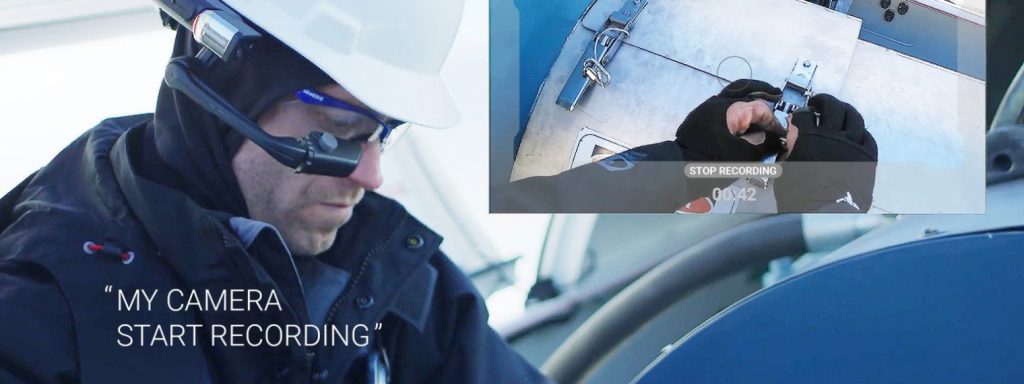

We have all heard of AR i.e. Augmented Reality but Assisted Reality, what is that? Well, considering that Augmented Reality gets all the spotlight – let us introduce Assisted Reality as the less popular cousin of AR.
Assisted Reality is a technology that allows a person to view a screen within his or her immediate field of sight, hands-free. It differs from AR in the sense that the information in display is not overlaid onto a physical environment.
Augmented Reality may be a more popular technology compared to Assisted Reality but it comes with its drawbacks. When used as a manufacturing or frontline tool, AR has not proven to be practical and is often unsafe for workers in many use cases.
Assisted Reality (aR) on the other hand, is arguably more practical as well as accessible for mechanics, service technicians, and other professional field workers to use at present time. Whereas Augmented Reality (AR) is still in its early stages. More like an idea that needs time & effort to be grown into a more practical and accessible version of itself.
Assisted Reality is a Reality first, Digital second experience. It allows people to have access to the right information when they need it while giving them 100% situational awareness as the provided information is not overlaid with a real-world view.
Understanding Assisted Reality:
Let’s take a look at HUDs (Heads-up displays). The HUDs in vehicles do not impair the vision of the driver or distract him or her. Instead, they provide an extra layer of information that is relevant without having the driver entirely shift his or her view to the dashboard. The driver’s hands are free to control the steering wheel while they keep their eyes on the road.
This is a simple and straightforward example that can help you grasp a clear concept of Assisted Reality.
There are also wearable Assisted Reality devices. They are designed this way to be more practical in use under certain situations. Examples include:
Note: Most aR use cases are not dependent on SLAM (simultaneous location and mapping) Computer Vision.
RealWear & Assisted Reality:
RealWear’s HMT headsets or wearable computer devices incorporate Assisted Reality into one of the most innovative designs that are proudly leading Digital Transformations in multiple industries.
These Android-based headsets are hands-free and work using voice recognition; they are specially designed to ensure the safety of frontline workers across various industries.
Take a look at two of RealWear’s best Assisted-Reality devices:
These wearable computers are being used at companies across the world in different industries. They ensure the safety of frontline workers, technicians, mechanics, and other service professionals who work in highly volatile & hazardous environments. The RealWear HMT devices also make work operations more effective, efficient, and productive.
Keep reading to learn about the 5 great benefits of Assisted Reality.
Now, let’s go over these benefits in a little more detail.
The RealWear HMT devices are tailor-made for industrial environments. They are durable, rugged, and sturdy. The headsets are compatible with a variety of personal protection equipment like hazmat suits, safety goggles, corrective eyewear, hard hats, masks, and ear protection. This ensure they fit for nearly every industrial environment.
Thanks to Assisted Reality, the RealWear wearable computers give workers access to relevant information wherever and whenever want it. The HMT devices can display most forms of multimedia including:
The RealWear devices have powerful wireless connectivity. This includes:
The RealWear HMT-1 also has an optional LTE modem attachment that extends a 4G cellular link. It is possible to acquire the same information on other devices but laptops are inconvenient, tablets require both hands and smartphones can be dropped easily. All these smart features make workers informed, aware, and knowledgeable – Making them efficient and productive.
A lot of times, frontline workers require extra support or guidance. This is often not possible due to the unavailability of mentors or experts at the same work sites or even the same time zones in some situations. RealWear assisted reality devices are equipped with high-resolution cameras, noise-canceling microphones & headphones. Remote experts can see what the worker is seeing in real-time with video calls. This enables onsite workers to seek the guidance of remote experts and solve issues on the spot.
RealWear headsets are essentially Android devices in the form of headsets. This means that whatever can be performed on an Android tablet or phone can be performed on a RealWear device. For example:
Reduces Costs
The ability to collaborate safely with professionals or any stakeholder — in dangerous environments can help organizations save heavy operational costs. These may include the international travel costs of multiple experts. Moreover, workplace accidents can be reduced effectively with fewer experts present on the actual work sites. Several organizations have experienced quicker first-time resolution times. They then increased first-time fix rates with the help of assisted reality. As they reduce equipment downtime, facilities can go back to operating costs at maximum capacity.
These are just a few of the many benefits that can be acquired out of Assisted Reality devices like RealWear’s own HMT-1 & HMT-1Z1 wearable computers. You can visit our website to learn more about Assisted Reality & Wearable Computers and the latest news about RealWear’s headsets & innovative technological advances.


7/84-90 Lakewood Blvd, Braeside,
Victoria, 3195
Australia
Tower 5, Level 17, 5 Temasek Blvd,
Suntec City,
Singapore
hello@realtimear.com
+61 477 220 887
Just let us know a bit about yourself and leave the rest to our experienced consultants. We have assisted 100+ organisations in Australia and the Asia Pacific with their digital transformation projects.